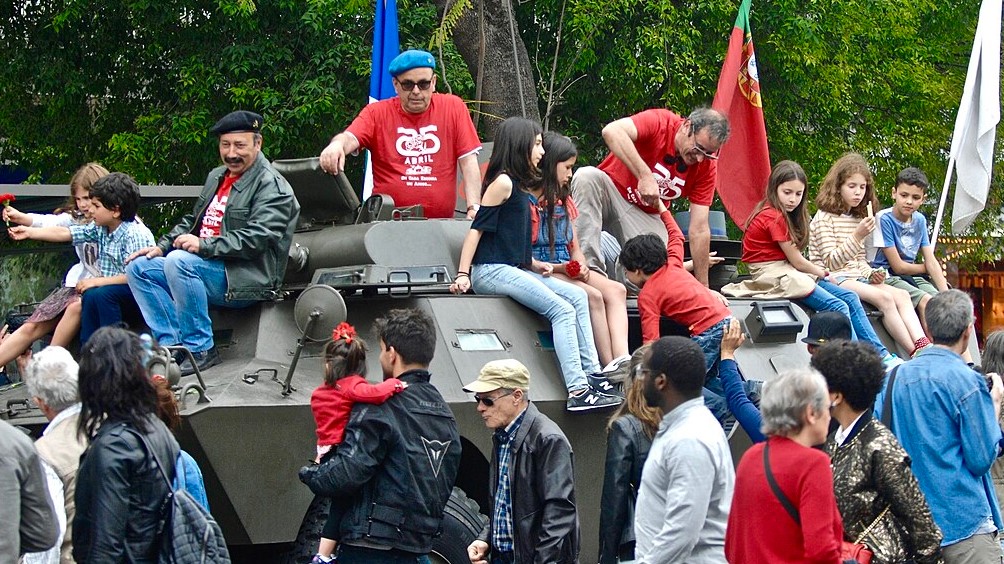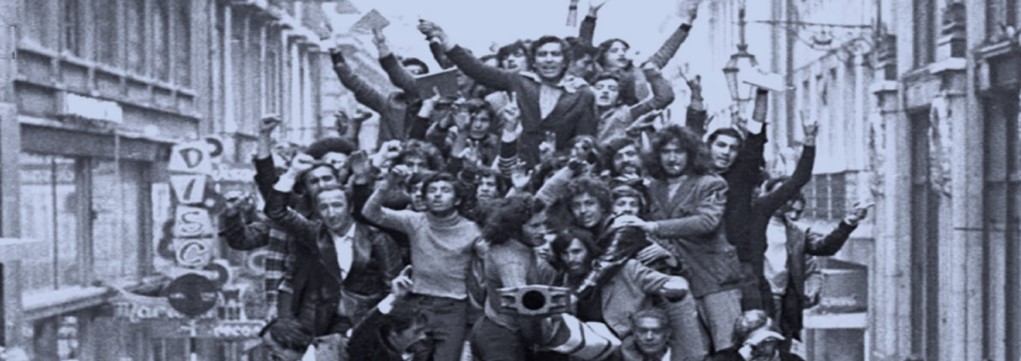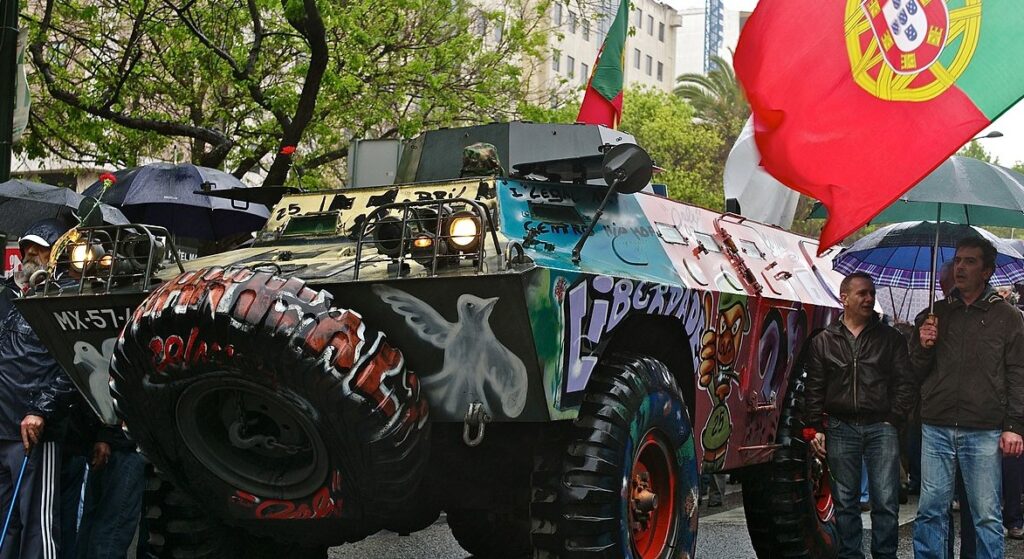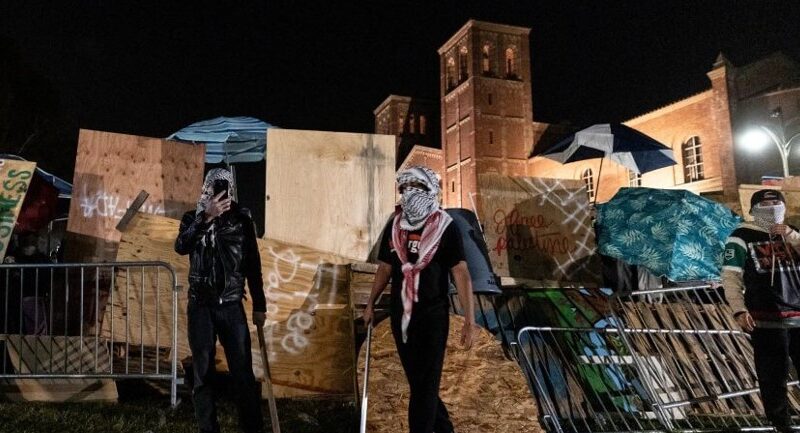By Greg Oxley
Fifty years ago this week, April 25 1974 saw the beginning of a revolutionary movement in Portugal, initiated by army officers, but quickly growing to encompass millions of urban and rural workers and youth. In the first part of his two-part article here, Greg Oxley, editor of the French Marxist paper, La Riposte, described the unfolding of those titanic events and the impetus of the movement towards social change. Here, he continues a description of subsequent events:
………………………………………………………………..
The ruling class, having lost control of the situation, could only place their hopes in General Spinola. The Armed Forces Movement of officers, the MFA, the Socialists and the Communists, stood well to his left, and the masses involved in the revolution stood well to the left of them.
On September 28, 1974, in a desperate attempt to change the relationship of forces within the government and then, he hoped, within society, Spinola attempted to carry out a ‘palace revolution’ in the name of what he called the “silent majority”. He had previously arranged for the resignation of the Prime Minister, Carlos Palma, a moderate liberal, as a first step towards a rightward shift in the government.
Spinola was trying to strengthen his presidential powers, and have the election of a Constituent Assembly postponed for another two years. But the manoeuvre failed and Spinola was forced to resign himself. Nonetheless, he continued his counter-revolutionary activity, backed by powerful capitalists in Portugal and by foreign governments.
On March 11, 1975, Spinola attempted to take power by mobilising fascist military units, with the support of reactionary peasant smallholders in the north. The operation again backfired, provoking a massive mobilisation in defence of the revolution, and Spinola was decisively defeated. The fascist instigators were arrested, and the army units involved were disbanded.
Spinola fled to Spain and then to Brazil, where he set up a fascist militia called the Liberation Army of Portugal. Nonetheless, in Portugal itself, his role was over. Far from having re-established capitalist ‘law and order’, this latest counter-revolutionary move gave a new and powerful impetus to the revolution.
In the government, Colonel Otelo Saraiva de Carvalho, “Otelo”, came to the fore. After having met Fidel Castro in Cuba, he wanted to push Portugal in a more markedly revolutionary direction, and he called for the establishment of “revolutionary councils”. The Prime Minister, the left-wing Brigadier Vasco Gonçalves, despite possessing a considerable personal fortune and business interests, introduced a program of expropriations aimed at reducing the power of the capitalist class.
Long list of nationalisations
Banks, insurance, fertilisers and petrochemicals, shipping, mining, farming, fishing, transport, cement, tobacco, iron, steel, forestry and wood, glass, breweries, radio stations, were all to be brought into state ownership. Significantly, foreign exchange and the building industry were not included in the list of nationalisations. As it happened, the father of Vasco Gonçalves owned a large foreign exchange business, in which the Prime Minister was a shareholder. Vasco Gonçalves was also the director of a large enterprise in the building industry.

This “coincidence” led to widespread protests from workers, but also gave a powerful argument to the opponents of the revolution. Another challenge to the revolution came from the more than half a million Portuguese citizens who had fled from the newly-independent African colonies, incensed by the ‘betrayal’ of their colonial interests by the new government.
The shift to the left in government policy reflected the enormous pressure for decisive change coming from the working class. In the south, agricultural labourers seized control of the estates, turning some 2,200,000 acres of land into collective farms. The mass movement on the land to establish workers’ control of farming went far beyond the intentions of the government, which intervened in some cases to give land back to the former owners.
In the rural north, the situation was very different. There were no big farms and a large number of smallholders who formed a significant social basis for the counter-revolution. Communist Party offices were burned down, left-wing municipal authorities were thrown out by rioting farmers. The Catholic Church hierarchy was firmly in the camp of the counter-revolution, and played a key role in agitating for the overthrow of the new regime. The Archbishop of Braga declared that “the present struggle is not of man against man, but of Christ against Satan”.
In the United States, in Britain and in other major imperialist countries, the turn of events in Portugal was seen as a major threat to European capitalism. Time Magazine wrote that “the troika of generals that has just assumed unlimited powers in Lisbon could well transform Portugal into Western Europe’s first communist nation”. The New York Times wrote that “a communist takeover of Portugal might well encourage a similar trend in Italy and in France, affect the succession in Spain, and send tremors through Western Europe”.
CIA and other agencies channelled money into reactionary groups
Now unclassified documents of the US State Department show that the CIA and other secret service agencies were funnelling millions of dollars both to openly counter-revolutionary organisations, to military leaders deemed as “moderates”, to the right-wing of the Portuguese Socialist Party and right-wing groups within the trade unions, often in the form of “solidarity” donations channelled through the International Confederation of Trade Unions, with which the CIA had been involved for many years and was now attempting to use for counter-revolutionary purposes, just as had been done in Chile in 1973.
Unclassified State Department documents dated from November 15th, 1975, also show that meetings took place between US Secretary of State, Henry Kissinger, German Chancellor, Helmut Schmidt and British ‘Labour’ Foreign Secretary, James Callaghan, detailing an agreement. It was that in the event of a civil war in Portugal they would all send arms and finances to counter-revolutionary forces.
Clearly, for world imperialism, the Portuguese Revolution had to be defeated at all costs. However, the preferred strategy for defeating the revolution was not open civil war, but reliance of the hesitation and political confusion of the workers’ leaderships and on moderate, non-revolutionary elements within the armed forces. Kissinger, Callaghan and Schmidt were in contact with a number of moderate high-ranking officers known as “the Group of Nine”, which worked to pressure the government into halting the revolution, turning it against any independent, that is to say uncontrolled, movement of the working class.

Indignant speeches and protests were not enough. Otelo Saraiva de Carvalho and Brigadier Vasco Gonçalves ranted against “imperialist plots” and “counter-revolution”, but tragically, they failed to present a serious program of action to disarm their enemies and to mobilise the working class to purge the state apparatus of hostile and conciliatory elements. These latter were standing in the way of a decisive revolutionary victory, and it was necessary to defeat them to complete the process of expropriations, placing power firmly in the hands of the workers, with a state apparatus based on and in defence of that power.
Communist Party leader an admirer of Stalin
The leader of the Communist Party, Álvaro Cunhal, a particularly obtuse admirer of Stalin’s regime of terror, had no independent policy or revolutionary strategy whatsoever. His line of conduct amounted to enjoying his prestigious position in the provisional government and “staying close” to the MFA leadership, come what may. When he was still in power, he and the other ‘Communist’ leaders styled Spinola as a ‘revolutionary democrat’, appealing to him to take measures against counter-revolutionary forces, as if Spinola himself was not a key representative of these same forces.
With the revolutionary upsurge that followed the failure of Spinola’s attempted putsch, a bold call from the CP leadership would have made a decisive difference. The CP, with its considerable influence and support, could have called for elected action committees uniting urban and rural workers with the lower ranks of the armed forces. These could have been the basis for a decisive break with capitalism, through revolutionary expropriations under workers’ control and management. It would have met with a powerful response from the masses, giving them a clearer idea of what needed to be done and how to do it.
But instead of this, the Cunhal leadership was constantly on the lookout for allies in the “liberal bourgeoisie”, as a cover for their own conciliatory policy. In substance, the political horizons of the CP went no further than formal “democracy” under capitalist rule. For Cunhal, the mass movement was not as a force for decisive revolutionary change, but merely as a source of support and applause for himself and his military allies.
The policy of Cunhal and the CP was essentially a rehash of the treacherous Stalinist “theory of stages”, which had condemned so many revolutions to defeat in the past. The essential characteristic of this so-called theory is that there is always some intermediary stage in the struggle when, in alliance with “progressive” capitalist forces, capitalist rule is left intact, before a constantly postponed final (revolutionary) stage which, in practice, never comes.
After Spinola had failed to halt the revolutionary movement, capitalist interests in Portugal and their supporters among foreign imperialists placed their hopes in the leadership of the Portuguese Socialist Party, which, in the absence of any independent revolutionary policy on the part of the CP, was gradually able to assert its influence as a vehicle for dampening the revolutionary spirit of the workers, regaining control of the situation and the protection of capitalist interests.
Elections to the Constituent Assembly
The elections to the Constituent Assembly in April 1975, which were the first free elections held in the country since 1926, showed an extremely high level of participation, with 91% of registered voters taking part. The Socialist Party led by Mario Soares won 37% of the vote, followed by the Popular Democratic Party (later to become the Social Democratic Party) with 26%. The Communist Party won only 12% of the vote.

The masses had tried, time and time again, to defend the revolution against its enemies, but the scope of their action had been constantly curtailed by the lack of a decisive leadership at the top prepared to take the revolution forward to a successful conclusion. Now the revolutionary tide was beginning to ebb.
The revolutionary and counter-revolutionary forces in Portugal were locked in a stalemate. The workers could not overcome the vacillating, conciliatory policies of their own “leaders” and deal a decisive blow to their enemies, and the counter-revolutionary forces were too weak, socially and militarily, to crush the working class. This created a chaotic and confusing situation.
The constant political and social turmoil was tiring out the workers and tended to isolate the most determined revolutionaries among them. This is the context which opened the way for the exhaustion and decline of the Portuguese revolution. Any revolution that stops halfway is lost.
In September 1975, Brigadier Vasco Gonçalves was sacked as Prime Minister by Spinola’s presidential successor, Francisco da Costa Gomes, signalling a shift to the right in government composition and policy and a growing confidence within reactionary circles. Then, on November 25, came what might be termed as the Portuguese revolution’s Thermidor.
Some leftist officers attempted a putch
Alarmed by the progress of the counter-revolution, some leftist officers close to Otelo Saraiva de Carvalho decide to take military action to put a halt to it, and to regain power for themselves. Paratroopers occuped the air bases of Tancos and Monte Real, and the headquarters of the Air Force high command. The Lisbon artillery regiment set up roadblocks.
However, on the same day, the armed forces under the control of the ‘Group of Nine’ also move into action. The leftist putsch was rapidly overwhelmed, and its instigators incarcerated. This day, more than any other, marked the end of the Portuguese Revolution, and the gradual consolidation of the counter-revolution, albeit in a ‘democratic’ and parliamentary form.
Taken as a whole, the Portuguese Revolution showed the tremendous capacity for struggle of the working class and the inherent revolutionary tendencies in the mass movement that were set in motion by the events of April 25, 1974.
A leadership is indispensible for victory
However, the dramatic events of the following year also underline one of the most important conclusions that can be drawn from the history of the modern working class, namely that without a firm revolutionary leadership, it is practically impossible, even in the most favourable circumstances, for the working class to come to power and create the conditions for its own social and political emancipation.
Furthermore, this leadership, indispensable for victory over capitalism, cannot be improvised and will not emerge ‘spontaneously’ in the generally short lapse of time that historical process affords to revolutionary movements. It must be prepared in advance, even if only in embryonic form, by the education and experience of the most conscious and resolute elements within the working-class movement, notably by the study of previous revolutions and the elaboration of a clear socialist program.
If we are to accomplish the vital task of preparing the socialist movement for the titanic storms that lie ahead in the coming years, then a discussion of the lessons of the Portuguese Revolution of 1974-1975 must surely occupy an important place.



